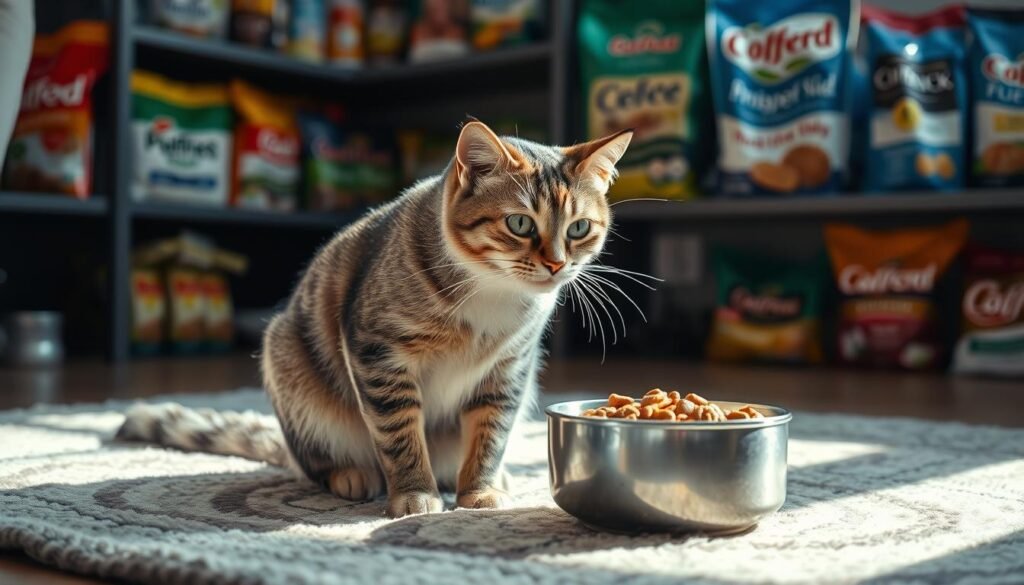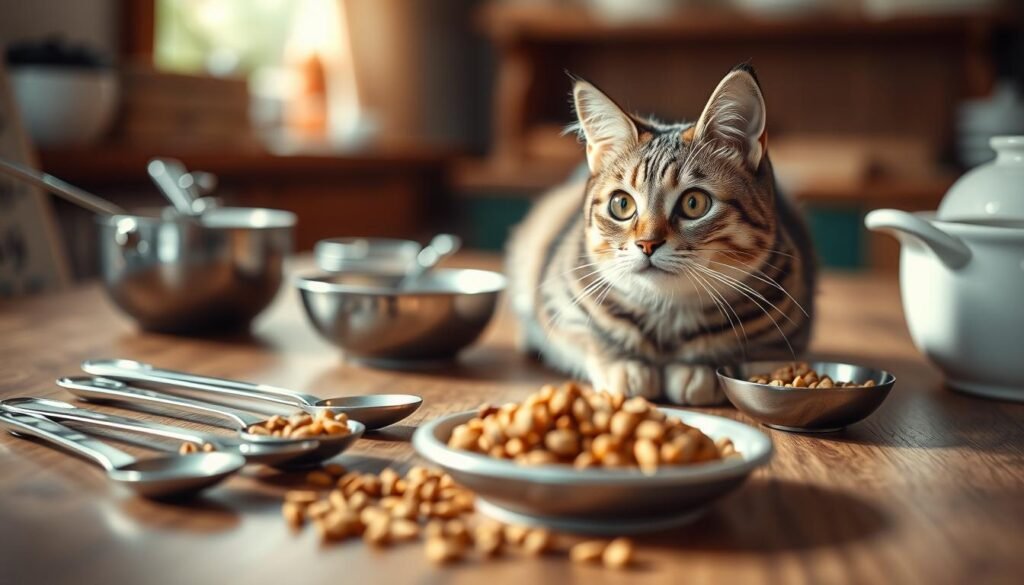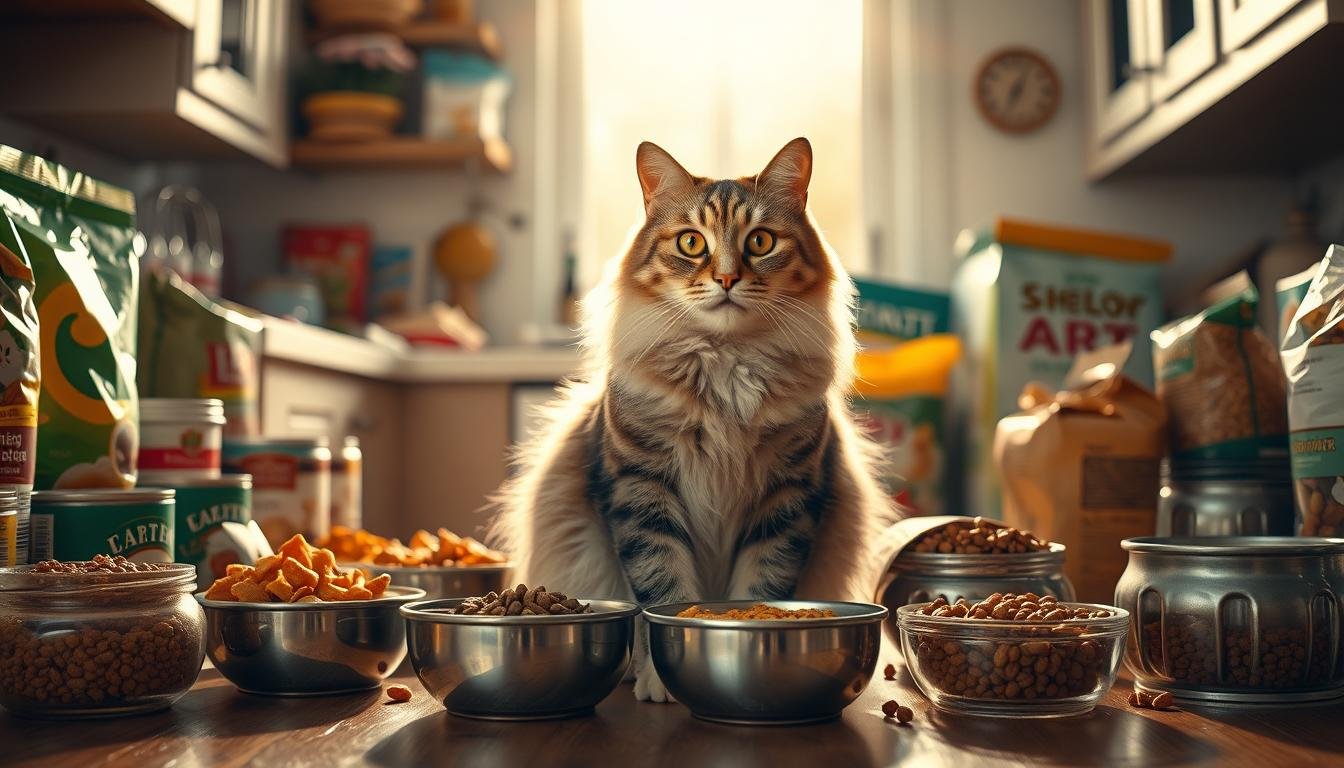Does Changing Cat Food Shocking Effects of Their Behavior
Table of Contents
As a cat owner, you’ve probably seen how your pet’s behavior changes with their diet. The link between cat food and behavior is complex. Switching your cat’s food can really affect them.
It’s important to understand how cat food and cat behavior are connected. A new diet might make your cat more energetic or reduce shedding. But, it could also cause stomach problems or stress.
Learning about the impact of cat food on behavior helps you choose the right food. This way, you can keep your cat happy and healthy.
The Connection Between Feline Diet and Behavior Does Changing Cat Food ?
The link between a cat’s diet and behavior is intricate. It involves many nutritional and biological factors. A cat’s eating habits can tell us a lot about their health and behavior. What they eat greatly affects their mood and actions.
How Nutrition Influences Your Cat’s Mood and Actions
Nutrition has a big impact on your cat’s mood and behavior. A diet full of essential nutrients can make your cat feel better. This can lead to a more balanced and calm cat.
Nutritional Elements and Their Effects:
| Nutrient | Effect on Behavior |
|---|---|
| Protein | Supports energy and overall activity levels |
| Omega-3 Fatty Acids | Promotes mental health and calmness |
| Vitamin D | Influences mood and overall well-being |
The Biological Basis of Food-Related Behavior
The biological reasons behind a cat’s food-related behavior are tied to their nutritional needs. Cats need a diet rich in protein from animal sources. Their behavior can change a lot based on whether their dietary needs are met.
Knowing the biological reasons behind your cat’s behavior can guide your diet choices. This can lead to better behavior and health for your cat.
Does a Change in Cat Food Change Cat Behavior?
Many pet owners worry about how changing cat food affects their pets’ behavior. It’s important to know how a diet change might impact your cat’s actions.
Switching your cat’s food can cause different reactions, from short-term to long-term. Knowing these effects helps make the change easier for your cat.
Short-Term vs. Long-Term Behavioral Effects
In the short term, cats might feel anxious or hesitant about new food. They might be picky or not want to eat. But, some cats adjust quickly and don’t show any big changes.
Long-term, cats might feel better and have more energy with the right food. But, some might not like the new food and get upset during meals.
Individual Variations in Feline Responses
Cats, like people, have their own likes and dislikes. Some cats will strongly react to new food, while others won’t notice a thing.
To show how cats can react differently to new food, here’s a table:
| Behavioral Change | Possible Cause | Potential Outcome |
|---|---|---|
| Increased appetite | More palatable food | Weight gain |
| Decreased appetite | Less appealing food | Weight loss |
| Improved energy | Nutritionally balanced diet | Enhanced activity levels |
Watching your cat closely when you change their food is key. This way, you can spot any bad reactions early and make changes to keep them happy and healthy.
Common Behavioral Changes When Switching Cat Food
Changing your cat’s food can affect their behavior. The link between cat food and behavior is complex. Switching cat food can cause different behavioral changes.
Positive Behavioral Changes to Expect
Some cats may show positive changes with new food. They might be more energetic, happier, and overall better. For example, a cat that was tired might start playing more with a nutrient-rich food.
A well-balanced diet can make your cat more stable and happy. Watching your cat’s behavior and adjusting their diet can help achieve these positive changes.
Negative Behavioral Reactions to Watch For
Some cats may not like the new food. They might eat less, have digestive problems, or seem stressed. It’s important to watch your cat closely during the change.
If your cat shows negative behaviors, see a vet to check for health issues. A gradual transition to the new food can also help avoid bad reactions.
Changes in Eating Patterns and Food Interest
Switching food can change how your cat eats and likes food. Some cats might be pickier or eat more. Understanding these changes helps manage their diet better.
| Behavioral Change | Possible Cause | Action to Take |
|---|---|---|
| Increased Energy | Nutrient-rich food | Monitor and adjust as needed |
| Decreased Appetite | Food not palatable | Gradually introduce new food |
| Digestive Issues | Sensitivity to new ingredients | Consult with a veterinarian |
Knowing these possible changes helps you smoothly switch your cat’s food. It ensures a better transition for your pet.
The Science Behind Food Ingredients and Cat Behavior
To understand how cat food changes behavior, we must look at the science behind it. The ingredients in cat food greatly affect their mood, energy, and behavior.
Proteins and Amino Acids: Impact on Mood and Energy
Proteins are key in a cat’s diet, giving them essential amino acids. Amino acids like tryptophan and tyrosine help control mood and behavior. A diet full of quality proteins can make cats behave better.
Carbohydrates: Effects on Activity Levels
Cats don’t need much carbs, but the carbs they do get can change their energy. Simple carbs can make blood sugar spike and then drop, making cats tired. But complex carbs give energy that lasts.
| Nutrient | Impact on Behavior | Food Sources |
|---|---|---|
| Proteins | Improves mood and energy | Chicken, Salmon, Beef |
| Carbohydrates | Affects activity levels | Sweet Potatoes, Brown Rice |
| Fats | Influences brain function | Fish Oil, Flaxseed |
Fats and Essential Fatty Acids: Influence on Brain Function
Fats, especially Omega-3 and Omega-6, are vital for brain health. They help with thinking and can reduce stress and anxiety in cats.
Additives and Preservatives: Potential Behavioral Triggers
Some cat foods have additives and preservatives that can change behavior.
“Certain artificial preservatives have been linked to hyperactivity in cats,”
say some vet nutritionists. It’s best to pick foods with natural preservatives to avoid bad behavior.
Different Types of Cat Food and Their Behavioral Effects
The type of cat food your feline friend eats can really affect their behavior and health. There are many options out there. It’s important for cat owners to know how different foods can change their cat’s behavior.
Dry Food vs. Wet Food: Behavioral Differences
Dry food and wet food have different effects on cats. Dry food is easier to store and cheaper, but it might not keep cats hydrated enough. Wet food, with more moisture, can help keep cats hydrated and might prevent urinary problems. This can make cats behave better.
A study showed that cats eating wet food felt fuller and were less stressed than those on dry food.
Raw Diets and Natural Feeding Approaches
Raw diets, which are like what cats would eat in the wild, can make cats more energetic and natural. They might hunt more like they do in the wild. But, it’s important to make sure the diet is balanced to avoid health problems.
“Feeding cats a raw diet can lead to a more natural expression of their instincts, potentially reducing behavioral issues related to boredom and lack of stimulation.”
Prescription and Specialized Diets
Prescription diets are made for cats with specific health issues. They can help with behavior problems too. For example, diets for urinary health can make cats less stressed about using the litter box.
Grain-Free and Limited Ingredient Diets
Grain-free and limited ingredient diets help with food allergies and sensitivities. Cats on these diets might be less anxious and stressed. Here’s a table showing how different cat foods can affect behavior:
| Cat Food Type | Potential Behavioral Effects |
|---|---|
| Dry Food | Potential decrease in water intake, possible increase in stress-related behavior |
| Wet Food | Better hydration, reduced stress-related behavior |
| Raw Diets | Increased energy, more natural hunting behaviors |
| Prescription Diets | Reduced behavioral issues related to specific health problems |
| Grain-Free/Limited Ingredient Diets | Reduced anxiety and stress-related behaviors |
Knowing about the different cat foods and their effects can help you choose the best diet for your cat. This can make your cat happier and healthier.
Food Allergies and Sensitivities: Impact on Cat Behavior
Knowing how your cat’s diet affects their behavior is important. Food allergies and sensitivities play a big role. They can change how your cat acts, but it’s not always easy to see.

Common Food Allergens for Cats
Cats can react to many things in their food. Beef, dairy, fish, and lamb are common culprits. So are some additives and preservatives. Finding out what your cat is allergic to is the first step.
Behavioral Signs of Food Sensitivities
Food sensitivities can make cats act differently. They might seem more anxious, aggressive, or tired. Some cats could start doing things compulsively or have accidents outside the litter box. Spotting these signs early is key.
Elimination Diets and Behavior Monitoring
An elimination diet helps figure out food allergies. It involves removing common allergens and then adding them back one at a time. Watching your cat’s behavior during this time is very important.
Understanding and dealing with food allergies and sensitivities can greatly improve your cat’s behavior and health.
How to Properly Transition Your Cat to New Food
Changing your cat’s food should be done slowly to keep them happy and healthy. Quick changes can upset them, causing stress and stomach problems. A slow transition helps avoid these issues.
The Gradual Transition Method
The gradual method mixes new and old food over 7-10 days. Start with a small amount of new food and add more each day. For example, start with 25% new and 75% old, then switch to 50% new and 50% old, and so on.
| Day | Old Food Percentage | New Food Percentage |
|---|---|---|
| 1-2 | 75% | 25% |
| 3-4 | 50% | 50% |
| 5-6 | 25% | 75% |
| 7+ | 0% | 100% |
Monitoring Behavioral Changes During Transition
Keep an eye on your cat’s behavior while changing their food. Look for signs of stress like less appetite, vomiting, or diarrhea. If you see any bad reactions, slow down the change or talk to your vet.
Strategies for Picky Eaters
For picky cats, try warming the new food or adding tasty liquid like low-sodium chicken broth. You can also feed it in a different place or at a different time to make it more interesting.
When Changing Your Cat’s Diet Becomes Necessary
Changing your cat’s diet is a big decision. It’s important to know why you’re making this change. This helps ensure your cat stays healthy and happy.
Health-Related Reasons for Diet Changes
Health problems often mean a diet change for your cat. Cats with diabetes need less carbs to control their sugar levels. Cats with kidney disease might need less protein and phosphorus. Talking to your vet can help find the right diet for your cat’s health.
Age-Related Dietary Adjustments
As cats get older, their diet needs change. Kittens need more protein and calories for growth. Older cats need fewer calories but easier-to-digest nutrients. Changing their diet can keep them healthy at any age.
Addressing Specific Behavioral Issues Through Diet
Diet can help with some cat behaviors. For example, food sensitivities can cause anxiety or aggression. Switching to a hypoallergenic diet might help. Always work with your vet to find the right diet for your cat’s behavior.
| Reason for Diet Change | Dietary Adjustment | Expected Outcome |
|---|---|---|
| Health Issues (e.g., diabetes, kidney disease) | Lower carbohydrate, reduced protein and phosphorus | Better management of health condition |
| Age-Related Needs | Adjusted protein, calorie, and nutrient levels based on life stage | Optimal health and development |
| Behavioral Issues (e.g., anxiety, aggression) | Hypoallergenic diet | Reduction in behavioral problems |

Case Studies: Real Examples of Food-Related Behavior Changes
Diet changes can make a big difference in cat behavior. Many cat owners and vets have seen this firsthand. They’ve noticed big changes in their cat’s behavior after changing their diet.
From Lethargic to Energetic: Success Stories
Some cats get tired easily because of what they eat. For example, a cat on a high-protein diet became much more active and playful. Nutritional adjustments can really improve a cat’s life.
Addressing Aggression and Anxiety Through Diet
Diet can help with a cat’s aggression and anxiety. A cat became less aggressive after eating more omega-3 fatty acids. These fats are good for the brain.
Resolving Litter Box Issues with Food Changes
Many cats have trouble with the litter box. But, changing their diet can help. For instance, a cat that had accidents outside the litter box got better after eating a special diet.
| Behavioral Issue | Dietary Change | Outcome |
|---|---|---|
| Lethargy | High-protein diet | Increased energy |
| Aggression | Omega-3 rich diet | Reduced aggression |
| Litter box issues | Specialized digestive health formula | Improved litter box behavior |
These stories show how important diet is for cat behavior. By choosing the right food, cat owners can fix many behavioral problems. This makes their cat’s life better overall.
Expert Opinions: What Veterinarians Say About Diet and Behavior
Expert veterinarians share insights on how diet affects cat behavior. The link between what cats eat and their behavior is complex. It involves nutrition and psychology.
Veterinary Nutritionists’ Perspectives
Veterinary nutritionists say a balanced diet is key for your cat’s health and behavior. Dr. Jennifer Larsen notes, “The right mix of proteins, fats, and carbs is vital for energy and mood.”
A study by the American Veterinary Medical Association shows diet changes can help with cat behavior. For example, omega-3 fatty acids can lower anxiety and aggression.
| Nutrient | Impact on Behavior | Food Sources |
|---|---|---|
| Protein | Enhances energy and mood | Chicken, Salmon |
| Omega-3 Fatty Acids | Reduces anxiety and aggression | Fish Oil, Flaxseed |
| Carbohydrates | Influences activity levels | Sweet Potatoes, Brown Rice |
Behavioral Specialists’ Insights
Behavioral specialists say diet changes are key in managing cat behavior. Dr. Sophia Yin notes, “Changing cat food can greatly impact their behavior, especially with food sensitivities or allergies.”
Some cats may show increased aggression or fear due to food ingredients. Removing these ingredients can greatly improve their behavior.
Conclusion: Balancing Diet Changes and Behavioral Well-being
Changing your cat’s food can really affect their behavior. A good cat food change can make them happier and more active. But, a bad change can make them act out in ways you don’t want.
To make a smooth change, think about what your cat needs. Watch how they act and change their food if needed. Knowing how food and behavior are linked helps you make better choices for your cat.
Being careful with food changes can help your cat feel better. It’s all about understanding what they need and how they react. This way, you can make sure your cat is happy and healthy.

